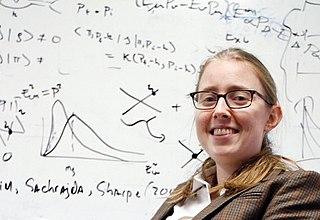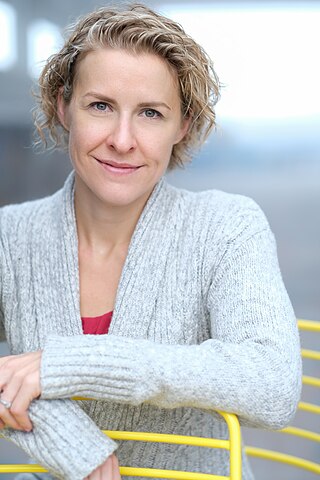Sir Michael Pepper is a British physicist notable for his work in semiconductor nanostructures.
Margaret Mary Murnane NAS AAA&S is an Irish physicist, who served as a distinguished professor of Physics at the University of Colorado at Boulder, having moved there in 1999, with past positions at the University of Michigan and Washington State University. She is currently Director of the STROBE NSF Science and Technology Center and is among the foremost active researchers in laser science and technology. Her interests and research contributions span topics including atomic, molecular, and optical physics, nanoscience, laser technology, materials and chemical dynamics, plasma physics, and imaging science. Her work has earned her multiple awards including the MacArthur Fellowship award in 2000, the Frederic Ives Medal/Quinn Prize in 2017, the highest award of The Optical Society, and the 2021 Benjamin Franklin Medal in Physics.
Amanda Susan Barnard is an Australian theoretical physicist working in predicting the real world behavior of nanoparticles using analytical models and supercomputer simulations and applied machine learning. Barnard is a pioneer in the thermodynamic cartography of nanomaterials, creating nanoscale phase diagrams relevant to different environmental conditions, and relating these to structure/property maps. Her current research involves developing and applying statistical methods and machine/deep learning in nanoscience and nanotechnology, and materials and molecular informatics. In 2014 she became the first person in the southern hemisphere, and the first woman, to win the Feynman Prize in Nanotechnology, which she won for her work on diamond nanoparticles.

Gerhard Klimeck is a German-American scientist and author in the field of nanotechnology. He is a professor of Electrical and Computer Engineering at Purdue University School of Electrical and Computer Engineering.

Anne Geneviève L'Huillier is a French physicist, and professor of atomic physics at Lund University in Sweden.
Michelle Louise Coote FRSC FAA is an Australian polymer chemist. She has published extensively in the fields of polymer chemistry, radical chemistry and computational quantum chemistry. She is an Australian Research Council (ARC) Future Fellow, Fellow of the Royal Society of Chemistry (FRSC) and Fellow of the Australian Academy of Science (FAA).
Robert Graham Clark is an Australian physicist. He was appointed Professor and Chair of Energy Strategy and Policy at University of New South Wales (UNSW) in 2012. Prior to this he was Chief Defence Scientist from 2008 to 2011 and Professor of Experimental Physics at University of New South Wales, where he established the National Magnet Laboratory and Semiconductor Nanofabrication Facility.

Jun Ye is a Chinese-American physicist at JILA, National Institute of Standards and Technology, and the University of Colorado Boulder, working primarily in the field of atomic, molecular and optical physics.

The ARC Centre of Excellence in Future Low-Energy Electronics Technologies is a collaboration of physicists, electrical engineers, chemists and material scientists from seven Australian universities developing ultra-low energy electronics aimed at reducing energy use in information technology (IT). The Centre was funded in the 2017 ARC funding round.
Olga Anatolevna Kocharovskaya is a distinguished professor of physics at Texas A&M University, known for her contributions to laser physics, quantum optics and gamma ray modulation.
Halina Rubinsztein-Dunlop is a professor of physics at the University of Queensland and an Officer of the Order of Australia. She has led pioneering research in atom optics, laser micro-manipulation using optical tweezers, laser enhanced ionisation spectroscopy, biophysics and quantum physics.

Aditi Sen De is an Indian scientist, a professor in quantum information and computation group at the Harish-Chandra Research Institute, Allahabad. She was born on 1st October 1974 in Kolkata, India. She is known for her research on quantum information and computation, quantum communication including quantum cryptography, quantum optics and many-body physics. The Council of Scientific and Industrial Research, the apex agency of the Government of India for scientific research, awarded her the Shanti Swarup Bhatnagar Prize for Science and Technology for her contributions to physical sciences in 2018. She is the first female physicist to be given this honour. In 2022, she was elected as a member of Indian Academy of Sciences and Indian National Science Academy.
Susan Nan Coppersmith is an American condensed matter physicist. Formerly the Robert E. Fassnacht Professor of Physics and Vilas Research Professor in the Department of Physics at the University of Wisconsin–Madison, she moved in 2018 to the University of New South Wales.
Monika Schleier-Smith is an American experimental physicist studying many-body quantum physics by precisely assembling systems of ultracold atoms. These atomic, molecular, and optical physics (AMO) engineered systems have applications in quantum sensing, coherent control, and quantum computing. Schleier-Smith is an associate professor of physics at Stanford University, a Sloan Research Fellow, and a National Science Foundation CAREER Award recipient. Schleier-Smith also serves on the board of directors for the Hertz Foundation.
Lindsay J. LeBlanc is a Canadian atomic physicist. She is an associate professor of physics at University of Alberta and the Tier 2 Canada Research Chair for Quantum Simulation with Ultracold Quantum Gases. Her work involves quantum simulation, quantum memory, and developing hybrid quantum systems.

Andrea Morello is the Scientia Professor of quantum engineering in the School of Electrical Engineering and Telecommunications at the University of New South Wales, and a Program Manager at the ARC Centre of Excellence for Quantum Computation and Communication Technology (CQC2T). Morello is the head of the Fundamental Quantum Technologies Laboratory at UNSW.

Deblina Sarkar is an electrical engineer, and inventor. She is an assistant professor at the Massachusetts Institute of Technology (MIT) and the AT&T Career Development Chair Professor of the MIT Media Lab. Sarkar has been internationally recognized for her invention of an ultra thin quantum mechanical transistor that can be scaled to nano-sizes and used in nanoelectronic biosensors. As the principal investigator of the Nano Cybernetic Biotrek Lab at MIT, Sarkar leads a multidisciplinary team of researchers towards bridging the gap between nanotechnology and synthetic biology to build new nano-devices and life-machine interfacing technologies with which to probe and enhance biological function.

Phiala Elisabeth Shanahan is an Australian theoretical physicist who lives and works in the United States. She is known for her work on the structure and interactions of hadrons and nuclei and her innovative use of machine learning techniques in lattice quantum field theory calculations.
Francesca Ferlaino is an Italian-Austrian experimental physicist known for her research on quantum matter. She is a professor of physics at the University of Innsbruck.

Stephanie Simmons is the co-chair of the Advisory Council on Canada's National Quantum Strategy and a Canadian Research Chair in Quantum Computing at Simon Fraser University. She is also the founder and Chief Quantum Officer at Photonic Inc., a spin out company which focusses on the commercial development of silicon photonics spin qubits. She was named by Caldwell Partners as one of Canada's Top 40 Under 40 in 2020. Her research considers the development of silicon-based systems for quantum computing.









